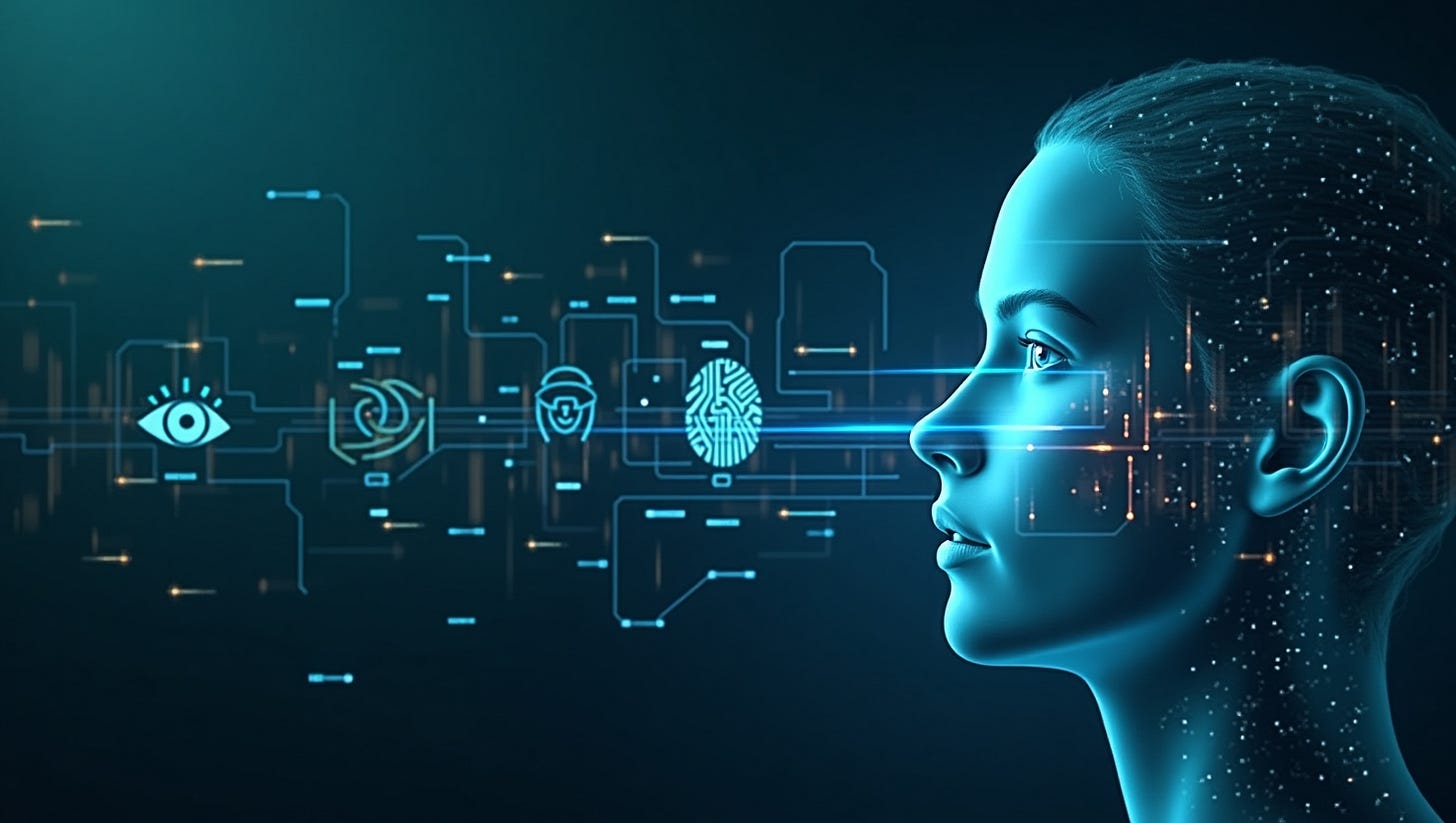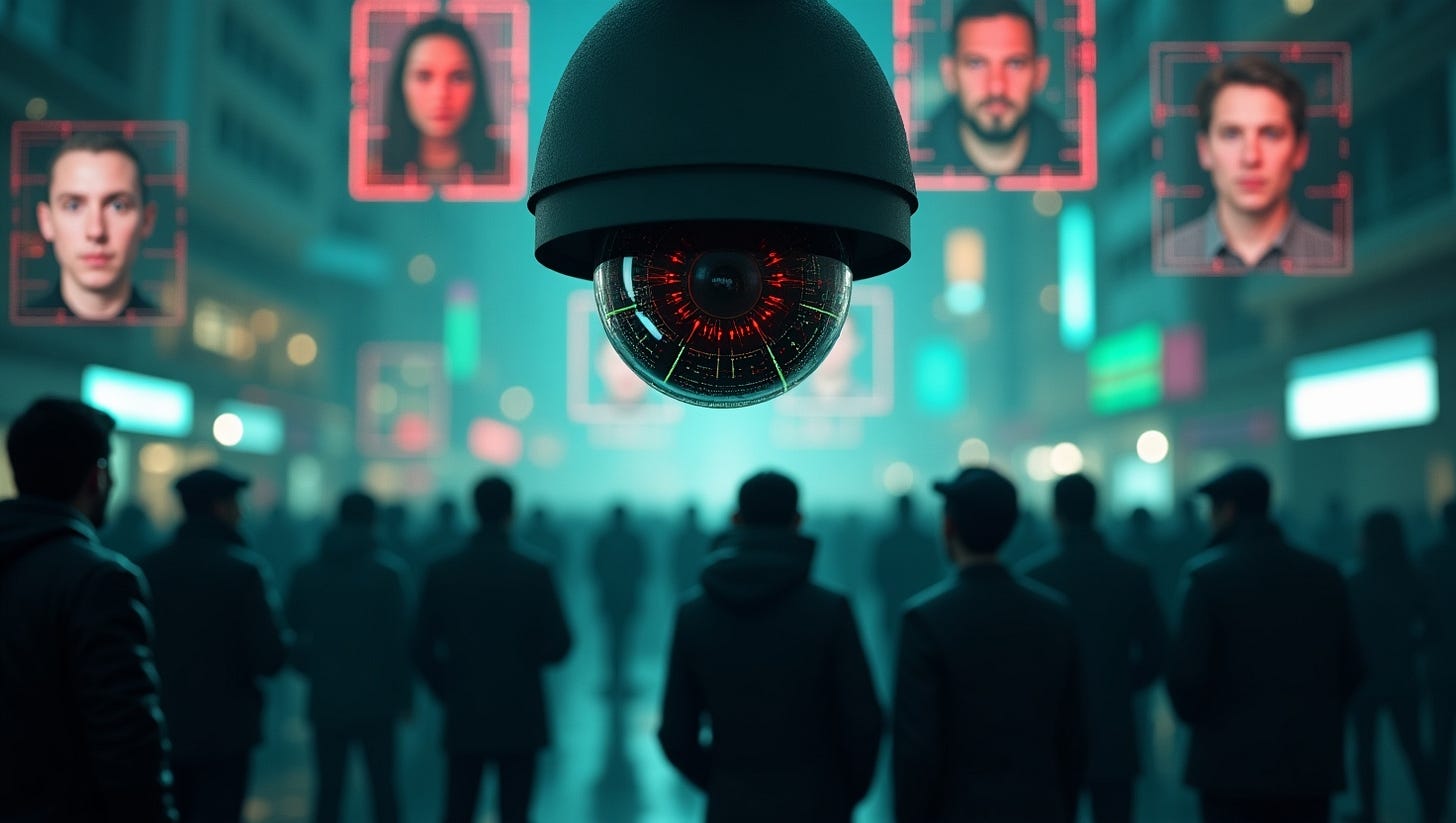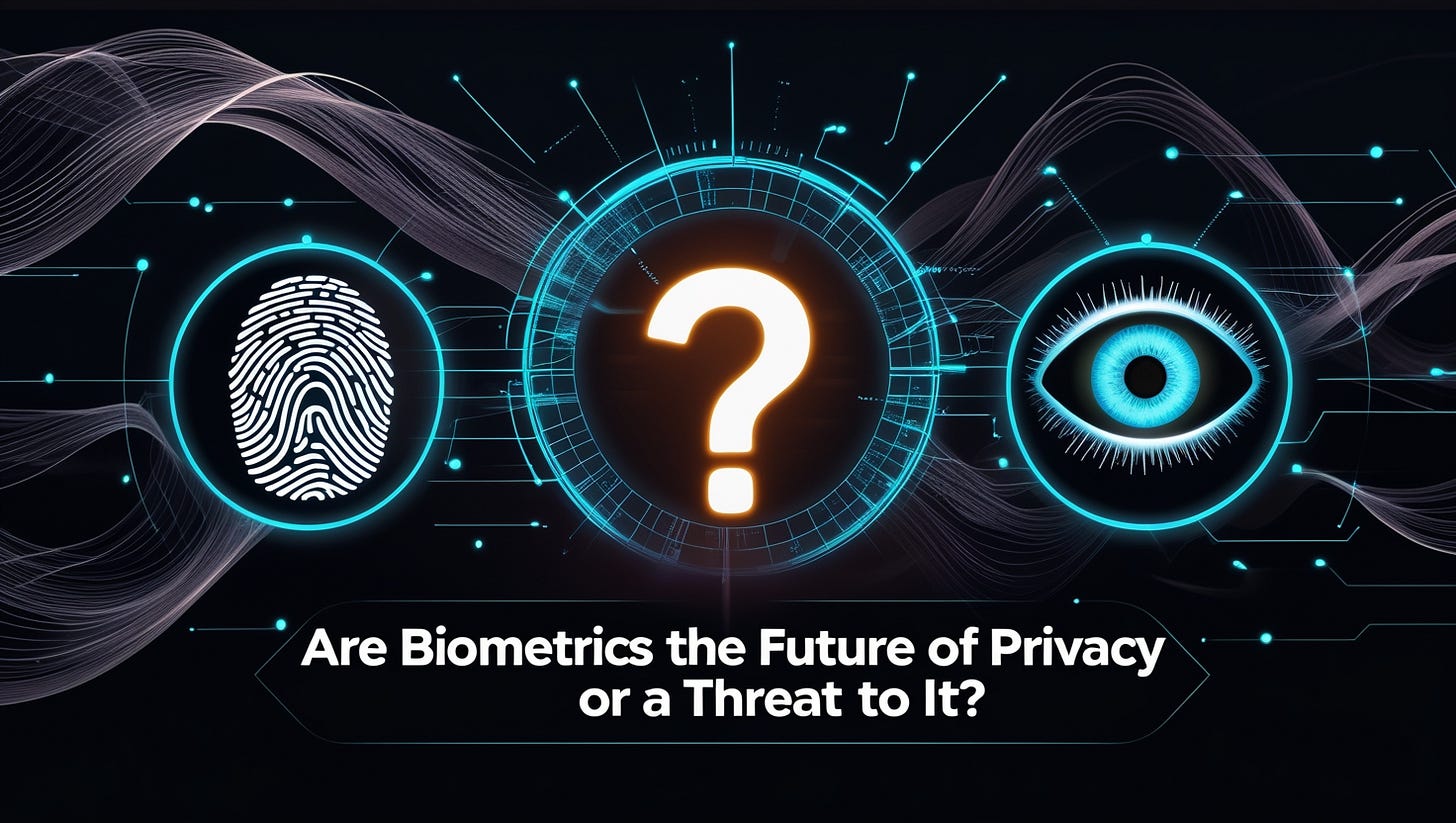What if your face wasn’t just yours anymore?
Biometric technology has quietly reshaped how we live, locking and unlocking our digital lives with a glance, a touch, or the sound of our voice. But as your most personal traits—your face, fingerprints, and even your DNA—become the keys to convenience, they’re also becoming targets. And unlike passwords, you can’t just change your fingerprint or reset your face.
Governments are watching. Corporations are collecting. Hackers are adapting. The rise of biometrics is more than a technological leap; it’s a gateway to unprecedented surveillance and potential abuse. Imagine a world where every movement, every transaction, every glance is tracked—and now realize that world is already here.
In this blog, we’ll uncover the shadow side of biometrics: how it’s being weaponized for control, the dangers of compromised data, and the slippery slope of surveillance creeping into every corner of life. More importantly, you’ll learn how to stay ahead of the curve—protecting your privacy and your identity in a world that’s increasingly designed to watch your every move.
What Are Biometrics?
Biometrics are the cornerstone of modern authentication—unique, physiological or behavioral identifiers that enable systems to verify identity with precision. Unlike traditional credentials such as passwords or PINs, which can be shared, forgotten, or brute-forced, biometrics are inherently tied to an individual’s biological or behavioral traits, making them a key tool in identity verification and access control.
At their core, biometric systems operate by capturing specific traits—like facial structure, fingerprint ridges, or vocal patterns—and converting them into digital templates through advanced algorithms. These templates are stored in databases or encrypted locally, where they are matched against input data for authentication. Biometric solutions have become pervasive, facilitating secure access in areas such as endpoint devices (smartphones and laptops), payment systems, border control, and even workforce management.
The advantages of biometric authentication are clear: increased usability, reduced reliance on vulnerable passwords, and often higher accuracy in identity verification. For example, facial recognition algorithms use deep learning to detect unique patterns, while fingerprint scanners analyze minutiae points that are nearly impossible to replicate.
However, the reliance on biometrics introduces new security considerations. Unlike a password, biometric data is immutable—it cannot be reset or changed once compromised. This makes biometric databases a high-value target for threat actors. Furthermore, the widespread adoption of this technology raises questions about data ownership, storage methods, and adherence to regulations like GDPR or CCPA.
To grasp the full implications of biometric technology, it’s crucial to understand both its mechanics and its applications. Before delving into its vulnerabilities, let’s examine where biometrics have become ubiquitous—and why they’re now a fundamental aspect of the modern security landscape.
The Benefits of Biometrics
Biometric technology has revolutionized authentication by offering a level of convenience and security that traditional methods often lack. As the digital world becomes increasingly interconnected, biometrics have emerged as a preferred solution for identity verification across industries. Here’s why:
1. Unparalleled Convenience
Biometrics eliminate the need for remembering complex passwords or carrying physical tokens like ID cards. A fingerprint scan or facial recognition check can grant access instantly, streamlining processes for both users and organizations. This convenience is why biometrics have become the go-to authentication method for personal devices, such as smartphones, and services like digital payments.
Example: Apple’s Face ID and Android’s fingerprint scanners enable users to unlock devices, authorize transactions, and access apps with just a touch or glance.
2. Enhanced Security
Biometrics leverage the uniqueness of biological traits, which are significantly harder to replicate or steal compared to passwords. Advanced algorithms analyze detailed patterns—like minutiae points in fingerprints or the geometry of a face—making biometric spoofing increasingly difficult.
Example: In sectors like banking, biometrics are being used to strengthen multi-factor authentication, combining something you are (biometrics) with something you know (a PIN) or something you have (a device).
3. Scalability and Integration
Biometric systems are highly adaptable and can be integrated into various applications, from personal use to large-scale deployments. Airports now use facial recognition for seamless passenger processing, while healthcare providers implement biometrics to secure patient records and prevent identity fraud.
Example: At Dubai International Airport, travelers can pass through security checkpoints using facial scans, significantly reducing wait times.
4. User Adoption and Familiarity
With biometrics embedded in everyday devices, users have grown more comfortable with the technology. This widespread acceptance has paved the way for broader adoption in areas like access control, secure payments, and workforce management.
Example: The World Economic Forum predicts that biometrics will be a key enabler for the future of digital identity, replacing passwords entirely in some systems.
While biometrics deliver clear benefits in terms of security and usability, they’re not without their challenges. The same traits that make biometrics so effective also create vulnerabilities when this data is mismanaged or exploited. Next, we’ll delve into the risks and ethical dilemmas posed by the increasing reliance on biometric systems.
The Dark Side of Biometrics
For all their advantages, biometrics are far from flawless. The very traits that make them effective—uniqueness, permanence, and convenience—also create significant vulnerabilities. As adoption expands, the darker side of biometric technology has come into sharper focus, raising serious concerns about security, privacy, and ethical misuse.
1. The Irreversible Risk of Data Breaches
Unlike passwords or tokens, biometric data is immutable. If your facial scan or fingerprint template is stolen, you can’t simply reset it. This makes biometric databases a high-value target for cybercriminals. Once compromised, the implications can be far-reaching.
Case Study: The 2019 breach of the U.S. Customs and Border Protection database exposed tens of thousands of travelers’ facial recognition data, sparking fears of identity theft and surveillance abuse.
Key Concern: Many organizations fail to implement robust encryption or secure storage protocols for biometric data, increasing the risk of exposure.
2. Mass Surveillance and Erosion of Privacy
Facial recognition systems are increasingly being deployed for surveillance, often without public consent. Governments and private entities can use this technology to monitor individuals in real time, raising ethical questions about how far surveillance should go.
Example: Cities like London and Beijing use facial recognition-equipped CCTV networks to track citizens, citing security benefits. However, critics argue this creates a dystopian environment where privacy is sacrificed in the name of safety.
Key Concern: Surveillance disproportionately targets marginalized communities, as algorithmic bias often results in higher rates of misidentification for people of color and women.
3. Algorithmic Bias and Misidentification
Biometric systems, particularly facial recognition, are only as unbiased as the data they’re trained on. Poorly trained algorithms have led to real-world consequences, including wrongful arrests and systemic discrimination.
Case Study: In 2020, a Black man in Detroit was falsely arrested due to a faulty facial recognition match. Such cases highlight the dangers of relying on incomplete or biased datasets.
Key Concern: Algorithmic bias undermines trust in biometric systems and raises questions about accountability in automated decision-making.
4. Lack of Consent and Oversight
Biometric data is often collected without explicit consent, particularly in public spaces or during routine transactions. Individuals may not even be aware their data is being captured or stored.
Example: Retailers have been found using facial recognition to track shoppers’ movements and behavior, often without informing them.
Key Concern: Without clear regulations, companies and governments can collect and use biometric data with minimal accountability, creating a significant power imbalance.
5. The Slippery Slope of Biometric Normalization
As biometrics become ubiquitous, the normalization of constant monitoring risks eroding societal expectations of privacy. What begins as a convenience can quickly transform into a mechanism for control.
Example: Workplace biometrics, such as fingerprint-based time tracking, have been criticized for enabling excessive monitoring of employees’ behaviors and movements.
Key Concern: Without proper checks, the widespread use of biometrics could pave the way for authoritarian practices and digital oppression.
Looking Ahead
The dark side of biometrics highlights the need for vigilance as this technology becomes more entrenched in daily life. While its potential benefits are undeniable, the risks—if left unchecked—could have lasting consequences for privacy, security, and personal freedom.
Next, we’ll explore actionable steps you can take to protect yourself and your data in a world increasingly driven by biometric authentication.
How to Protect Your Privacy in a Biometric World
Biometric technology is here to stay, but that doesn’t mean you have to surrender your privacy. By understanding the risks and taking proactive measures, you can strike a balance between embracing convenience and safeguarding your identity. Here’s how:
1. Limit Your Use of Biometrics
While biometrics are convenient, they aren’t always the safest option. Use them selectively and only when the benefits outweigh the risks.
What to Do: Opt for traditional authentication methods, like strong passwords or PINs, for non-critical apps and devices.
Example: Avoid using facial recognition to unlock social media accounts, as these platforms often lack the robust security of banking apps or enterprise systems.
2. Opt Out When Possible
Many systems and services offer alternatives to biometric data collection—though they may not always advertise them.
What to Do: Check for options to disable or opt out of biometric collection. For instance, many airports and retail stores now allow manual identity verification upon request.
Example: When traveling, ask airlines or border control agents for non-biometric screening methods, such as manual ID checks.
3. Know Your Rights
Different regions have varying regulations around biometric data. Staying informed can help you hold organizations accountable for their use of your personal information.
What to Do: Familiarize yourself with laws like the General Data Protection Regulation (GDPR) in Europe or the California Consumer Privacy Act (CCPA) in the U.S. These laws often grant you the right to access, delete, or restrict the use of your biometric data.
Example: If you’re in a region covered by these regulations, you can request that companies delete your biometric data or explain how it’s being used.
4. Use Devices with On-Device Storage
Not all biometric systems are created equal. Some store your data in centralized databases, which are more vulnerable to breaches, while others keep it securely on your device.
What to Do: Choose devices and services that store biometric templates locally and encrypt them, such as Apple’s Secure Enclave or Android’s Trusted Execution Environment.
Example: When purchasing a smartphone or wearable device, research how it handles biometric storage and security.
5. Embrace Multi-Factor Authentication
Relying solely on biometrics for security can be risky, especially if your data is compromised. Combining biometrics with other authentication factors adds an extra layer of protection.
What to Do: Enable multi-factor authentication (MFA) wherever possible. Use a combination of biometrics, a strong password, and a secondary method, like a hardware token or one-time code.
Example: A bank app that uses facial recognition to log in but also requires a PIN for transactions provides better security than biometrics alone.
6. Be Wary of Public Biometric Systems
Publicly accessible biometric systems, such as surveillance cameras or shared devices, can pose significant privacy risks.
What to Do: Avoid situations where your biometrics are captured without your consent, and be cautious of biometric scanners in public spaces.
Example: Some retail stores now use facial recognition to track shoppers—choose to shop elsewhere if they don’t disclose or justify their practices.
The Power of Proactive Awareness
Biometrics may feel inevitable, but by staying informed and proactive, you can protect your privacy while still benefiting from the technology’s convenience. Remember: your data is valuable, and it’s up to you to control how it’s shared and used.
Next, we’ll explore how governments, businesses, and innovators are working to balance the promise of biometrics with the growing demand for privacy and ethical oversight.
The Future of Biometrics—Balancing Innovation and Privacy
As biometrics evolve, new technologies are set to transform how we interact with the digital world. From enhanced security to seamless personalization, the possibilities are vast—but so are the challenges. The future of biometrics will hinge on balancing innovation with ethical responsibility.
1. Emerging Technologies in Biometrics
The next wave of biometrics goes beyond fingerprints and facial recognition:
Behavioral Biometrics: Systems that analyze patterns in how you type, swipe, or walk, offering an additional layer of security.
Multimodal Biometrics: Combining factors like voice, iris scans, and facial recognition to reduce errors and enhance reliability.
Biometric Encryption: A method where encryption keys are generated and secured using biometric data, making them both unique and harder to compromise.
2. Privacy-Preserving Innovations
To address rising concerns about data misuse, developers are exploring technologies designed to protect users’ biometric information:
On-Device Processing: Ensuring biometric data is stored and processed locally rather than in centralized databases, reducing risks of breaches.
Federated Learning: Training biometric systems on devices instead of relying on cloud-based storage.
Zero-Knowledge Proofs: Enabling verification without revealing the underlying biometric data itself.
3. Balancing Innovation with Accountability
The future of biometrics depends on creating systems that protect user rights while enabling progress:
Stronger Regulation: Governments must establish clear rules for how biometric data is collected, stored, and used.
Corporate Responsibility: Companies need to prioritize transparency, encryption, and user consent.
Ethical Frameworks: Developers must address issues like algorithmic bias to ensure fairness and inclusivity in biometric systems.
As biometrics become more ingrained in daily life, the responsibility lies with individuals, businesses, and governments to ensure these systems enhance security without compromising privacy. The next steps we take will shape whether biometrics fulfill their promise—or become a tool for exploitation.
Key Points
Biometrics are shaping the future of security, offering unparalleled convenience—but at what cost? As we’ve uncovered, the risks to privacy, security, and personal freedom are real and growing. While this technology can empower us, it requires careful oversight and informed use to avoid exploitation.
Now it’s your turn:
What do you think? Are biometrics the key to a safer future, or do they pose too great a risk to privacy? Let me know your thoughts in the comments—I’d love to hear your perspective.
If you found this blog insightful, don’t keep it to yourself. Share it with your network and help spark a conversation about the future of biometrics. And if you haven’t already, subscribe to Beyond The Firewall to stay ahead of the curve. For just $5/month or $45/year, you’ll gain access to exclusive content, early posts, and more.
Looking ahead, I’ve got some groundbreaking blogs planned for 2025, including:
"The Death of Anonymity: Can You Ever Be Invisible Online Again?"
Exploring how data brokers, surveillance tech, and social media have made true digital anonymity nearly impossible."AI vs. AI: The Cybersecurity Battle of Machine vs. Machine"
A deep dive into how AI is both powering cyberattacks and defending against them, with examples of machine-on-machine battles in the wild."When Hackers Target the Human Mind: The Rise of Neuro-Hacking"
Investigating how brain-computer interfaces and neurotech could open doors to unprecedented types of cyberattacks."The Invisible Threat: Hacking Without Code in the IoT Era"
How attackers are exploiting smart devices through physical means—like sound waves and electromagnetic pulses—instead of traditional hacking methods.
The conversation doesn’t end here. Let’s navigate the evolving world of cybersecurity and technology—together.
Stay Informed. Stay Secure. Stay Curious.











What are your thoughts about using Biometrics to access Apple Devices? Have they changed since you last updated the IPhone Safety Checklist? My thoughts are to remove access and disable FaceID for all apps and access to the devices. While it is very convenient to use, it's also very convenient for nefarious people to obtain access to it from you without your consent. From a security perspective, it seems logical to disable it.
China used biometrics to identity Uyghurs.